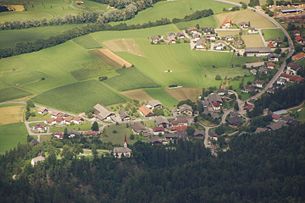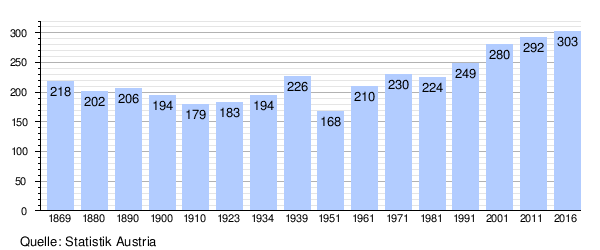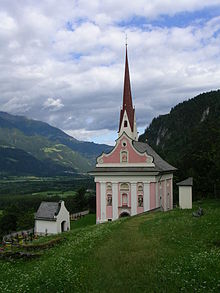Lavant (Tyrol)
|
Lavant
|
||
|---|---|---|
| coat of arms | Austria map | |
|
|
||
| Basic data | ||
| Country: | Austria | |
| State : | Tyrol | |
| Political District : | Lienz | |
| License plate : | LZ | |
| Surface: | 22.55 km² | |
| Coordinates : | 46 ° 48 ' N , 12 ° 50' E | |
| Height : | 675 m above sea level A. | |
| Residents : | 330 (January 1, 2020) | |
| Postal code : | 9906 | |
| Area code : | 04852 | |
| Community code : | 7 07 14 | |
| NUTS region | AT333 | |
| Address of the municipal administration: |
Lavant 61 9906 Lavant |
|
| Website: | ||
| politics | ||
| Mayor : | Oswald Kuenz (Lavant village list) | |
|
Municipal Council : (2016) (11 members) |
||
| Location of Lavant in the Lienz district | ||
 Lavant, view from the Laserzwand |
||
| Source: Municipal data from Statistics Austria | ||
Lavant is a municipality in the Lienz district in Tyrol in Austria with 330 inhabitants (as of January 1, 2020). The community is located in the judicial district of Lienz .
geography
Lavant is located in the southeast (shady side) of the Lienz valley floor, east of the district capital Lienz, at 675 m above sea level. A. The municipality covers 22.55 km², making Lavant the tenth smallest municipality in the Lienz district.
topography
The municipality of Lavant extends from the valley of the Drau at around 640 m above sea level. A. in the northeast of the municipality over the slopes of the Lienz Dolomites at an altitude of around 2700 meters to the border with the federal state of Carinthia . The highest peak in the municipality is the Große Keilspitze at 2739 m above sea level. A. In addition, the community has the Wild Sender ( 2738 m above sea level ), the Kleiner Keilspitze ( 2712 m above sea level ), the Gamsköpf ( 2695 m above sea level ), the Grubenspitze ( 2671 m above sea level ) . ) and the Hochstadel ( 2681 m above sea level ) over other mountains over 2500 meters.
In addition to the Drau, several mountain streams flow in the Lavant area and drain the northern flank of the Laserz group. In addition to the Frauenbach, which forms a mighty, flat cone of rubble in the east of the municipality, these are the Dorfbach (also Auerlingbach or Talbach), the Tiefenbach, the Pernitzenbach, the Tiefenbach and the Haslerbach. All streams flow into the Auenlaue , which flows into the Drava in the municipality of Nikolsdorf.
climate
Since there is no measuring station in Lavant, exact records of the community's climate are missing. However, due to the proximity of the settlements to the weather station in the district capital Lienz, it is comparable with the climatic data measured there.
The coldest month of the year in the Lienz basin is January, the highest temperatures are measured in the summer months of July and August. The highest rainfall also falls in the summer months, with the month of October being almost as rainy. Fog rarely occurs in the Lienz Basin, but in winter, due to inversion weather conditions, mighty cold-air lakes form .
Community structure
The municipality of Lavant consists of a single cadastral municipality or locality of the same name . In addition to the village of Lavant, the community also consists of the hamlet of Wacht ( 647 m above sea level ).
Neighboring communities
Lavant borders four municipalities, three of which are in the Lienz district and one in Carinthia.
| Dölsach | ||
| Tristach |

|
Nikolsdorf |
| Lesachtal ( Hermagor district ) |
history
Human traces can be found in Lavant since the Neolithic. The Kirchbichl, an 810 m high elevation in the south of Lavant, was already settled in the time of the Celts . This striking mountain spur was also inhabited in the late period of the Roman Empire, which was only a few kilometers east of the then important city of Aguntum and offered protection in increasingly troubled times. At that time, mortar stone houses with underfloor heating were built.
The first churches were built in the 5th century. At the latest a victory of the Slavs over an army of the Bavarians near Aguntum around the year 610 ushered in the temporary decline of the settlement on the mountain. However, the settlement does not seem to have stopped. In the 8th century Lavant gained new importance as a strategically important point.
The place name is probably of Slavic origin and is documented in 1193 as "Lowat" . Since 1381 the Lords of Lavant were dependent on the Counts of Gorizia . The Kirchbichl was fortified in 1444, as evidenced by the gate system and the remains of the castle on the hilltop. At the top of the Kirchbich stands a church consecrated to St. Peter and St. Paul, a little below the old church of St. Ulrich, rebuilt in late baroque style .
coat of arms
The Lavant coat of arms was awarded to the municipality on April 13, 1976 by the Tyrolean provincial government.
The blazon reads:
- "Divided by silver and green obliquely on the left with a step, on top of it two black columns reaching up to the upper edge of the shield."
The coat of arms symbolizes the Lavanter Kirchbichl with the excavated remains of the early Christian bishop's church.
population
Population structure
In 2012, 298 people lived in the municipality of Lavant, making Lavant the third smallest municipality in the Lienz district in terms of population. According to the 2001 census, 97.5% of the population were Austrian citizens (Tyrol: 90.6%); by the beginning of 2012 the value had only fallen slightly to 96.3%.
The average age of the community population in 2001 was well below the national average. 22.5% of the residents of Lavant were younger than 15 years (Tyrol: 18.4%), 61.4% between 15 and 59 years old (Tyrol: 63.0%). The proportion of residents over 59 years of age was 15.7%, below the national average. The average age of the population of Lavant changed significantly as a result. The proportion of people under the age of 15 fell to 16.8% as of January 1, 2012, while the proportion of people between 15 and 59 years of age rose to 71.5%. By contrast, the proportion of people over 59 years of age fell to 11.7%.
According to marital status, in 2001 52.8% of Lavant's residents were 55.7 single, 36.4% married, 5.7% widowed and 2.1% divorced.
religion
For the Roman Catholic Church in 2001 96.1% of the population known (Tirol: 83.4%), 1.8% were Protestant , 2.1% had no religious beliefs.
Population development
The population of Lavant has fluctuated significantly over the past 150 years. Starting from 1869, the population fell by 18% until 1910, after which the population rose again and in 1939 again reached a little more than the initial value. After that, the population fell again by 27% and marked its lowest point in 1951 with 168 inhabitants. As a result, the population increased almost gradually, with the greatest increase occurring in the 1990s.
On January 1, 2016, the municipality of Lavant recorded its highest level to date with 303 inhabitants, whereby the growth in the last decade resulted from a slightly positive birth balance and a slightly positive migration balance. In contrast to the population growth in the Lienz district and in the state of Tyrol, the population growth in Lavant was below average.

economy
Workplaces and employees
The workplace census carried out as part of the census in 2001 revealed 17 workplaces with 99 employees (excluding agriculture) in Lavant, 93% of which were employees. The number of workplaces had risen by six companies (plus 55%) compared to 1991, and the number of employees rose by as much as 44 people (80%).
In 2001, the most important branch of the economy, measured by employment, was construction, with one company employing 32 people (32% of employment). The second largest employer was the “Mining and quarrying of stones and earth” sector with two companies and 21 employees (21%), followed by the “Provision of other public and personal services” sector with four workplaces and 18 employees (18%).
Of the 151 employed inhabitants of Lavant, only 39 people were employed in Lavant in 2001. 112 had to commute to work. Of the out-commuters, 47% had their place of work in the neighboring urban center of Lienz. Another 24% had found a job in the rest of the district, another 13 or 14% commuted to North Tyrol or another federal state, one of the residents had to commute abroad.
tourism
Tourism in Lavant is of great economic importance for the municipality, although many East Tyrolean municipalities have significantly higher numbers of overnight stays. The tourism intensity (overnight stays per inhabitant) is, however, the second highest in the entire district in summer. Lavant was able to count around 42,000 overnight stays in the 2011/12 tourism year. Since the turn of the millennium, Lavant has recorded enormous increases in overnight stays for both the winter and summer seasons. The overnight stays in the summer season between 2000 and 2012 increased from 1,845 to 30,641 overnight stays, and in the winter season between 1999/2000 and 2011/12 from 1,667 to 11,376 overnight stays. Of the 30,641 overnight stays in summer 2012, only 12% were Austrian, 79% German and 6% Swiss.
The enormous increases in the number of overnight stays are due to the Golf & Resort Dolomitengolf, which has a 27-hole golf course opened in 2000. There are also the Lavanterhof guest house and several private room rental companies. There are a total of around 200 guest beds in Labant. Today, like all other East Tyrolean municipalities, the municipality belongs to the East Tyrol Tourist Association, with Lavant being organized in the "Lienz Dolomites Holiday Region".
Transport and infrastructure
Lavant is accessed by traffic from Lavanter Straße L 318, which leads from Lienz via Tristach and Lavant to Dölsach and ends at Drautalstraße B 100.
Lavant is connected to the public transport network by buses operated by ÖBB-Postbus GmbH . Line 4404 connects Lavant around ten times on weekdays with the district capital Lienz, the journey time being 25 minutes and the route from Lienz via Nussdorf and Debant to Stribach, Dölsach and Gödnach. There is an additional connection from Postbus GmbH with line 4406, which connects Lienz with Dölsach and Nikolsdorf via Debant and is also served around ten times on weekdays.
The closest connection to the Drautalbahn railway network is in the neighboring communities of Lienz and Dölsach. The closest train stations are the train stations in Dölsach or Nikolsdorf of the Drautalbahn.
Lavant has joined forces with the neighboring municipalities of the Lienz basin to form the “Lienzer Talboden waste water association”, with the municipality's sewer system being completed between 2000 and 2001, with the exception of the Wacht district. The waste that arises in the community is disposed of by the Waste Management Association of East Tyrol (AWVO).
education
The elementary school in Lavant was opened in 1782 as a single-class elementary school. It was originally located in the sacristan's house and after a fire in 1875 moved to a building owned by the community. In 1969 the primary school was rebuilt, with the two primary school classes and the kindergarten being housed in the building. In 2000 the school was renovated and sports facilities were built. The elementary school Lavant has called itself "The village school at Talbach Lavant" since 1998. It had between 22 and 33 children per school year between the 2008/09 and 2012/13 school years. The secondary school students attend the main school in Debant, the closest grammar school is in Lienz.
Security and Healthcare
After the fire disaster in 1875, fire regulations for the municipality of Lavant came into force in 1879. Nevertheless, due to a lack of money, it took until October 27, 1889, when the Lavant volunteer fire brigade was founded in the presence of the 23 founding members and the then district association chairman. Initially, the fire brigade had a two-horse K 1600 land-based sprayer and equipment such as uniforms for 25 men. The first hydrant network went into operation in 1926. When the municipalities were amalgamated in 1939, the Lavant volunteer fire brigade was dissolved and placed under the command of the Tristach fire police as the "Lavant fire station". In 1949 the FF Lavant became independent again. In 1952 the first fire station was occupied and the first motor pump was purchased. The first motorized fire engine was purchased between 1967/68. Today the FF Lavant has a fire station as well as a small fire engine and a tank fire engine .
With regard to the health system, Lavant is organized together with the municipalities of Dölsach, Iselsberg-Stronach, Nikolsdorf and Nußdorf-Debant in the “Sozialsprengel Nußdorf-Debant and the surrounding area”. In the health district, for example, health services such as elderly and care assistance, home and household help, hospice and meals on wheels are organized.
Culture and sights
societies
- Dolomite golf
- Lavant Volunteer Fire Brigade
- Hunting horn blowers
- Hunting club
- church choir
- Rural youth
- Equestrian Club Pegasus
- Lavant Sports Union
- Lauentna sheet metal
freetime and sports
- Ice rink
- Football field
- Fun court system with basketball arena
- Golf course: 27-hole championship course against the backdrop of the Lienz Dolomites ("Dolomitengolf")
- Children's playground
- Curling lane
- Tennis court
- Gym with indoor climbing wall
- Riding school
The following sports can also be practiced:
- Hiking, Nordic walking, running, cycling. In winter also cross-country skiing and tobogganing.
literature
- Catholic Tyrolean Teachers' Association (Ed.): District Studies East Tyrol . Innsbruck 2001, ISBN 3-7066-2267-X .
Web links
- 70714 - Lavant. Community data, Statistics Austria .
- Lavant municipality
- History-Tyrol: Lavant
- The Lavant Churchbichl
Individual evidence
- ↑ Catholic Tyrolean Teachers' Association: District Studies East Tyrol , p. 108
- ↑ Martin Bitschnau , Hannes Obermair : Tiroler Urkundenbuch, II. Department: The documents on the history of the Inn, Eisack and Pustertal valleys. Volume 2: 1140-1200 . Universitätsverlag Wagner, Innsbruck 2012, ISBN 978-3-7030-0485-8 , p. 403-404, No. 913 .
- ↑ Provincial Law Gazette for Tyrol 1976 No. 26: "Announcement of the provincial government of April 13, 1976 on the award of a coat of arms to the municipality of Lavant"
- ↑ a b c d Statistics Austria municipality data from Lavant
- ↑ State Statistics Tyrol (VZ 2001) (PDF; 4.1 MB)
- ^ Office of the Tyrolean provincial government, Tyrolean provincial statistics
- ↑ State of Tyrol, wastewater disposal in the Lienz district ( Memento from September 22, 2013 in the Internet Archive ) (PDF; 7.2 MB)
- ↑ Catholic Tyrolean Teachers' Association: Bezirkskunde Osttirol , pp. 249–253
- ↑ Lavant municipality
- ↑ Lavant Volunteer Fire Brigade
- ^ Social district Nussdorf-Debant and the surrounding area ( Memento from December 3, 2016 in the Internet Archive )






